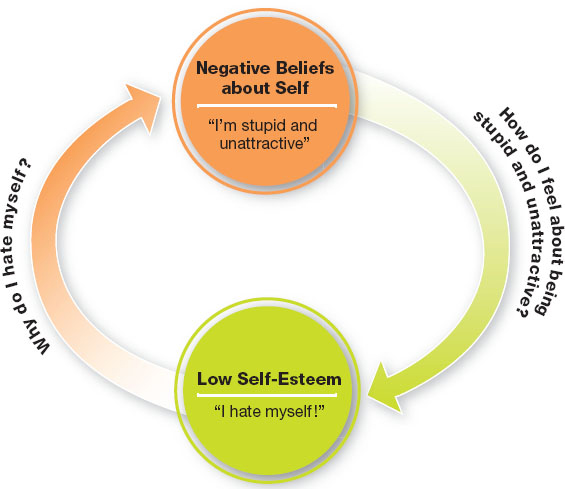2.1.3 Self-Esteem
Printed Page 40
Self-Esteem
Self-esteem is the overall value, positive or negative, that we assign to ourselves. Whereas self-awareness prompts us to ask "Who am I?" and self-concept is the answer to that question, self-esteem is the answer to the follow-up question, "Given who I am, what's my evaluation of my self?" When your overall estimation of self is negative, you'll have a meager sense of self-worth and suffer from low self-esteem. When your evaluation of self is positive, you'll enjoy high self-esteem.
Your self-esteem strongly shapes your interpersonal communication, relationships, and physical and mental health (Pyszczynski, Greenberg, Solomon, Arndt, & Schimel, 2004). In simple terms, when you're happy with yourself, this happiness radiates inward and outward. People with high self-esteem report greater life satisfaction, communicate more positively with others, and experience more happiness in their relationships than do people with low self-esteem (Fox, 1997). People with high self-esteem also exhibit greater leadership ability, athleticism, and academic performance (Fox, 1992). High self-esteem helps insulate people from stress and anxiety: people with high esteem report fewer anxiety-related disorders, and are better able to cope with stress (Pyszczynski et al., 2004). By contrast, low self-esteem can spawn a destructive feedback loop, as depicted in Figure 2.1.

Measuring Up to Your Own Standards The key to bolstering your self-esteem is understanding its roots. Self-discrepancy theory suggests that your self-esteem is determined by how you compare to two mental standards (Higgins, 1987). The first is your ideal self, the characteristics you want to possess based on your desires. This is the “perfect you”—the embodiment of all the attributes you consider admirable. These characteristics may be mental, physical, emotional, material, and even spiritual. The second standard is your ought self, the person others wish and expect you to be. This stems from expectations of your family, friends, colleagues, and romantic partners as well as cultural norms. According to self-discrepancy theory, you feel happy and content when your perception of your self matches both your ideal and ought selves: “I’m the kind of person I want to be” and “I’m the kind of person others wish me to be” (Katz & Farrow, 2000). However, when you perceive your self to be inferior to both your ideal and ought selves, you experience a discrepancy between your self and these standards and are likely to suffer low self-esteem (Veale, Kinderman, Riley, & Lambrou, 2003).

Improving Your Self-Esteem Your self-esteem can start to improve only when you reduce discrepancies between your self and your ideal and ought selves. How can you do this? Begin by assessing your self-concept. Make a list of the beliefs, attitudes, and values that make up your self-concept. Be sure to include both positive and negative attributes. Then think about your self-esteem. In reviewing the list you've made, do you see yourself positively or negatively?
Next, analyze your ideal self. Who do you wish you were? Be sure to consider the physical, mental, emotional, material, and spiritual aspects of your desired self. Is this ideal attainable, or is it unrealistic? If it is attainable, what would you have to change to become this person? If you made these changes, would you be satisfied with yourself, or would your expectations for yourself simply escalate further?
Third, analyze your ought self. Who do others want you to be? Can you ever become the person others expect? What would you have to do to become this person? If you did all of these things, would others be satisfied with you, or would their expectations escalate?
Fourth, revisit and redefine your standards. This step requires intense, concentrated effort over a long period of time. If you find that your ideal and ought selves are realistic and attainable, move to the final step described below. If you decide that your ideal and ought selves are unrealistic and unattainable, redefine these standards so that each can be attainable through sustained work. If you find yourself unable to abandon unrealistic and unattainable standards, don't be afraid to consult with a professional therapist or other trusted resource for assistance.
Finally, create an action plan for resolving any self-discrepancies. Map out the specific actions necessary to eventually attain your ideal and ought selves. Frame your new standards as a list of goals, and post them in your planner, cell phone, personal Web page, bedroom, or kitchen to remind yourself of these goals. Since self-esteem can't be changed in a day, a week, or even a month, establish a realistic time line. Then implement this action plan in your daily life, checking your progress as you go.